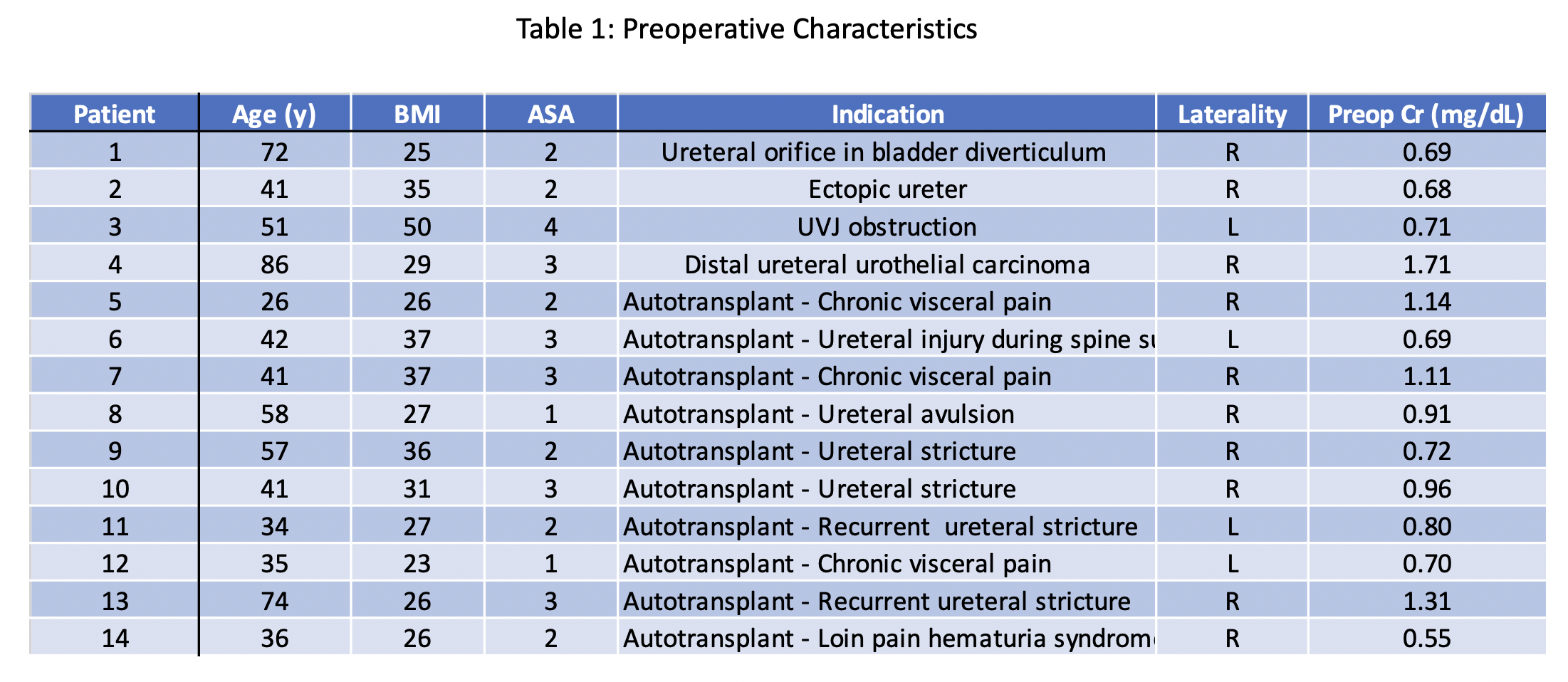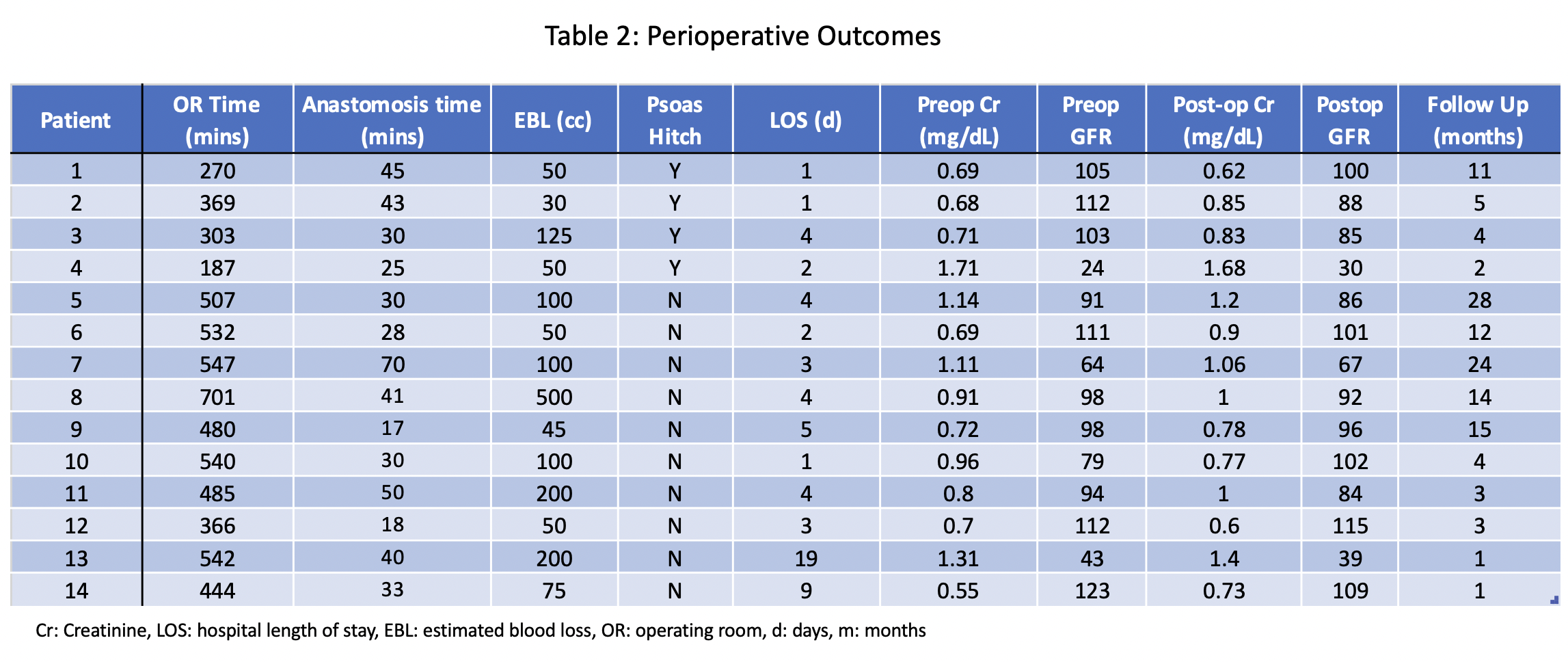Back
Introduction: Minimally invasive and robotic distal ureteral reconstruction has significantly reduced the perioperative morbidity associated with robotic ureteral reimplantation. We present our initial series of single-port (SP) robotic ureteral reimplantation which aims to demonstrate the feasibility of the approach and versatility of the SP platform as well as the favorable perioperative morbidity.
Methods: Inclusion indications for 14 consecutive patients included various benign and malignant conditions including ectopic ureter, distal ureteral stricture, bladder diverticula, renal autotransplantation, and distal ureterectomy for upper tract urothelial carcinoma. The primary outcome of this study was demonstration of the feasibility and versatility of the technique for a variety of benign and malignant conditions as well as evaluation of its perioperative morbidity. Patients are placed in the supine position and access is obtained using a floating dock technique. The SP is docked in addition to the robotic scissors, Maryland bipolar, and cadiere grasper. Following mobilization of the ureter, the bladder is freed to facilitate a tension-free anastomosis with or without a psoas hitch. The ureter is spatulated and anastomosed to the bladder dome in a water-tight fashion over a ureteral stent.
Results: Patients had a median age of 41 and ASA class of 2 (Table 1). All SP ureteroneocystotomies were performed successfully without any conversions to open (Table 2). Four patients required a psoas hitch. Median anastomosis operative time was 31.5 minutes and a median blood loss of 87.5cc. Hospital length of stay ranged from 1 to 19 days, with a median of 3.5 days, however was 1.5 days when renal autotransplants were excluded. Patients had excellent preservation of renal function at a median follow up of 4.5 months.
Conclusions: We demonstrate the versatility of the SP approach for ureteral reimplantation for a variety of benign and malignant conditions. Patients had favorable perioperative morbidity and preservation of renal function at follow up. SOURCE OF
Funding: none


Video Abstract Session
Session: V09: Reconstruction/Transgender
V09-09: Single Port Robotic Ureteroneocystostomy: A Versatile Approach for Ureteral Reconstruction
Sunday, April 30, 2023
10:50 AM – 11:00 AM CST
Location: Video Abstract Theater
- ZS
Video Presenter(s)
Introduction: Minimally invasive and robotic distal ureteral reconstruction has significantly reduced the perioperative morbidity associated with robotic ureteral reimplantation. We present our initial series of single-port (SP) robotic ureteral reimplantation which aims to demonstrate the feasibility of the approach and versatility of the SP platform as well as the favorable perioperative morbidity.
Methods: Inclusion indications for 14 consecutive patients included various benign and malignant conditions including ectopic ureter, distal ureteral stricture, bladder diverticula, renal autotransplantation, and distal ureterectomy for upper tract urothelial carcinoma. The primary outcome of this study was demonstration of the feasibility and versatility of the technique for a variety of benign and malignant conditions as well as evaluation of its perioperative morbidity. Patients are placed in the supine position and access is obtained using a floating dock technique. The SP is docked in addition to the robotic scissors, Maryland bipolar, and cadiere grasper. Following mobilization of the ureter, the bladder is freed to facilitate a tension-free anastomosis with or without a psoas hitch. The ureter is spatulated and anastomosed to the bladder dome in a water-tight fashion over a ureteral stent.
Results: Patients had a median age of 41 and ASA class of 2 (Table 1). All SP ureteroneocystotomies were performed successfully without any conversions to open (Table 2). Four patients required a psoas hitch. Median anastomosis operative time was 31.5 minutes and a median blood loss of 87.5cc. Hospital length of stay ranged from 1 to 19 days, with a median of 3.5 days, however was 1.5 days when renal autotransplants were excluded. Patients had excellent preservation of renal function at a median follow up of 4.5 months.
Conclusions: We demonstrate the versatility of the SP approach for ureteral reimplantation for a variety of benign and malignant conditions. Patients had favorable perioperative morbidity and preservation of renal function at follow up. SOURCE OF
Funding: none


